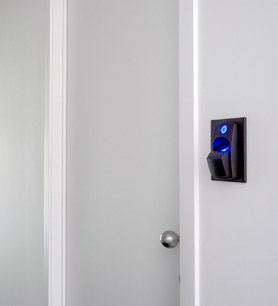Fingerprint recognition technology holds the largest single factor authentication segment in biometrics, and is predicted to continue to hold this pole position for the foreseeable future.
Richard Forsyth, UK and Ireland Sales Manager of ievo Ltd, the Newcastle-based manufacturer of biometric recognition systems, says of this growth: “In light of recent appalling terrorist attacks across the world, the need for security has never been greater. Whilst travel and immigration will no doubt continue to hold the largest share of the biometric system market, and the USA still the largest customer, I suspect the less dramatic use of fingerprint readers across a wide range of sectors is actually the main driver of growth, certainly for ourselves.
“The primary reason for this is that fingerprint recognition systems can provide a bigger return on your investment. Cheaper, more traditional alternatives such as numeric key pads or magnetic swipe cards have fundamental potential security flaws, which biometrics can hugely reduce. These potential flaws equate to the reliance on secondary credentials, which can be a continuous draw on a company’s budget, something that is not applicable to a biometric system. Biometric systems can also prevent theft through highly accurate data reporting and can highlight and monitor attendance patterns directly linked to individual users. This helps to keep both accurate staff working hours for payroll and can also provide accountability. Traditional systems using secondary credentials can be shared, lost or replicated, biometrics counter this potential flaw. Additionally, and probably of more importance to end customers, biometric recognition systems provide an infallible access control system that can be used for a variety of additional purposes without any additional cost involved.”
“A typical example may be a Government data centre where various levels of access are required. To be even considered for such a contract, the access control system would have to be CPNI (Centre for the Protection of National Infrastructure) approved, which we are, whilst our readers, which control access points such as turnstiles, barriers, doors or even data racks, integrate seamlessly with well-known access control systems from such global manufacturers as Paxton, PAC and Honeywell.
“The resultant data can be used not only for access control and reporting but also for personnel records such as payroll – indeed, this is particularly useful in the construction and industrial sectors when a large site will have a number of sub-contractors in addition to directly employed personnel; the access system becomes important not only for just security, but also for payrolls and contract payments.
“Within other sectors, biometric recognition systems are gaining market share for other reasons – within the education sector, for example, in addition to access control they are being used for foolproof library control and even the control of free school meals. Within the leisure sector, our gym operating clients, for example, prefer them to traditional means as they prevent any fraudulent entry and rapidly pay for themselves.”
Pictured courtesy of ievo; an office access use of the company’s Ultimate biometric product.









